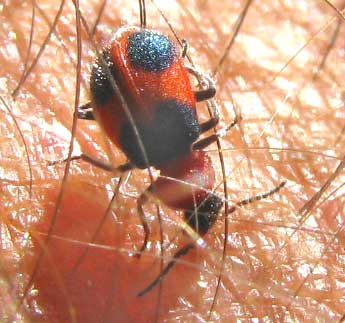Excerpts from Jim Conrad's
Naturalist Newsletter
from the December 19, 2010 Newsletter issued from Hacienda Chichen Resort beside Chichén Itzá Ruins, central Yucatán, MÉXICO; limestone bedrock, elevation ~39m (~128ft), ~N20.676°, ~W88.569°
COLLOPS THE VICIOUS LITTLE FLOWER-BEETLE
On a warm afternoon I sat in the sun peacefully reading beside the hut when a certain spot on my arm began hurting. It felt like an army ant starting to cut away a piece of me, something that occasionally happens, so without even bothering to focus on the little being I brushed it away without further ceremony. But instead of sailing through the air and staying lost, the critter made a U-turn in mid air -- an impossible maneuver for a thumped ant -- returned to my bare leg, and within a few seconds was gnawing there.
This time I looked more closely. He was smaller than most ants, maybe a little over 1/10th of an inch (3 mm) long, actually a red and black beetle, those colors in Nature often meaning "danger." Below, you can see him clinging to leg hairs, chewing on my skin.

Volunteer insect identifier Bea in Ontario figured out that he was a Collops beetle, genus Collops, a member of the Soft-Winged Flower Beetle Family, the Melyridae. These beetles eat the eggs, nymphs, and larvae of many insects, as well as the adult stages of various soft-bodied insects, plus we now know they're not above tearing into peaceful naturalists sitting behind their huts reading.
*About 67 species of the genus Collops occur in North America and the group doesn't seem to have been studied in our part of the world, so this is one of those times when we just can't say much more than that. We'll file the picture on the Internet and hope that one day an expert someplace in the world will be glad to see it, and learn that ours is a species given to nibbling on people.